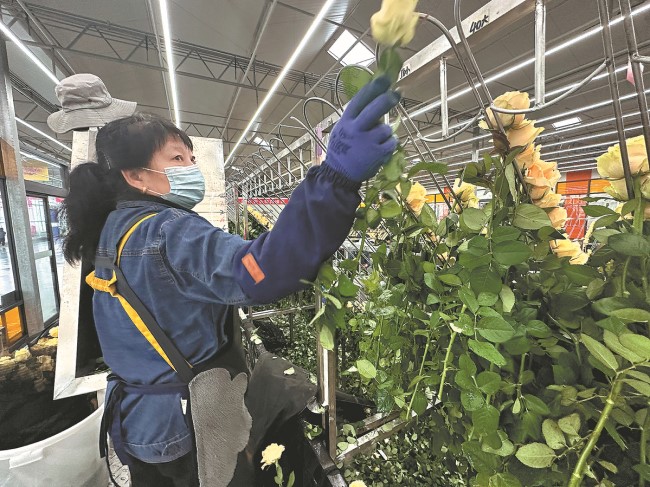Hefty investment helps flower industry come up roses in Linxia

A quality inspector classifies roses at a rose workshop in Linxia, Gansu province, last month. [Photo by Yan Dongjie for China Daily]
Russian flower merchant Rinad Ageev was more than pleased with his delivery of 200,000 fresh-cut roses that arrived by road in Moscow in October.
It was the first time that fresh roses had been exported from the Linxia Hui autonomous prefecture in Gansu, Northwest China, to Russia by road.
Not traditionally thought of as a rich growing region for roses, Northwest China is cultivating a name for itself as a new player on the block.
Roses grown in Linxia are even larger than those from Ecuador, a famous rose producing area, and some varieties are rarely seen in the surrounding areas, according to Ageev.
In August, over 10,000 fresh-cut roses from Linxia were exported to Kazakhstan. In the same month, more than 20,000 roses were exported to Russia via airfreight.
"From picking to packaging and air transportation, it took about eight days, and the transportation cost was 1.5 times the price of the flowers," said Ageev, who then turned to an unconventional way forward in the sector — by using cold-chain trucks.
These new channels for industry and trade have been made possible in part due to the implementation of the Belt and Road Initiative.
In a thank-you letter sent from Moscow, Ageev expressed his joy at the opening up of a new transportation channel along the Belt and Road and appreciated the assistance provided by the customs and trade departments in Gansu.
Ageev purchased his flowers directly from Linxia Yinong Agriculture and Animal Husbandry Investment Co.
Zhang Yongyou, general manager of the company, said the climate in Linxia is actually more suitable for rose cultivation than well-known rose-producing areas such as Yunnan.
The reason is partly the climate and partly the latest agricultural technology.
In 2021, the government of Linxia committed to developing a modern rose industry and invested more than 600 million yuan ($84 million) in automated temperature and humidity control systems, and integrated water and fertilizer systems from European countries such as Sweden.
From the Netherlands they imported high-quality rose varieties. More than 200,000 square meters of intelligent greenhouses have been built.
Due to the pandemic, local workers had to install the equipment with remote guidance, which took the best part of a year.
According to Zhang, the greenhouses ensure sufficient sunlight while preventing the burning of petals and leaves. The tops of the greenhouses are equipped with fully automated shading and supplementary lighting systems, and the temperature inside the greenhouses is maintained at the most suitable parameters for rose growth, regardless of extreme cold or hot weather.
Thanks to such intelligent systems, the cutting cycle for the roses has been shortened from two months to about one month, and the annual yield of fresh-cut roses per square meter can exceed 300.
Not only are these high-tech systems producing excellent results, they are also environmentally friendly, according to Zhang.
"The carbon dioxide produced by the boiler in winter is completely recovered and supplied to the roses for photosynthesis. After the roses adopt soilless cultivation, the water and fertilizer are then recycled and treated before being reused, achieving zero pollution."
Due to Linxia being located at around 2,000 meters above sea level, there are also fewer diseases and pests, Zhang said.
Despite its automation, more than 500 farmers from Fuhan town of Linxia have found employment at the rose growing base — so many, in fact, that locally it is referred to as the "rose factory".
In the workshop, dozens of workers are busy with picking, sorting, thorn removal and packaging. Approximately 200,000 roses are shipped nationwide and overseas every day. Zhang explained that from October to March, which is the peak season for roses, the storage rooms are usually empty.
Amid the fresh scent of roses, 32-year-old Xu Shuqin skillfully packages the flowers while humming a tune. She said her favorite among the dozen rose varieties planted at the base, such as the purple Fairy Xia, and the skirted Elsa, is the Naomi variety.
"I hope my life can be as prosperous as the flowers' red color," she said.
She said that there have been many orders recently, and she has to package over 4,000 flowers a day, which means her monthly income can exceed 5,000 yuan, which is similar to a local white-collar worker.
Zhang said the Phase II and Phase III development of the flower base are currently under construction. By next year, the planting area is expected to reach 67 hectares. Within five years, they plan to build 200 hectares of intelligent greenhouses, which will produce approximately 700 million fresh-cut roses per year, accounting for 10 percent of the national output and creating 5,000 job opportunities.
-
As AI encounters Dunhuang's art, the ancient caisson ceiling bridges centuries to the present.
View all stories

 Gansu thrives from green development
Gansu thrives from green development  >
>